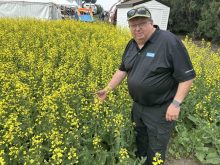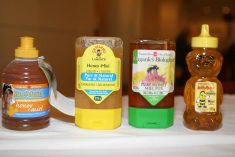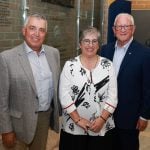SASKATOON – In prairie ditches this winter are tracks of one of the fastest-growing leisure activities.
Snowmobiling is a “huge, huge, huge industry North America-wise,” said Doug Baker of Snoman, the Manitoba snowmobile association. North American snowmobile drivers spend $1.5 billion on gas for their machines, clothing, new sleds and for hotels and restaurants.
That economic activity is seldom noticed because “people only see us in the ditch and the rest of the time we’re in the bush,” said Baker. “Our motto is travel light but carry a big wallet.”
Read Also

First annual Ag in Motion Junior Cattle Show kicks off with a bang
Ag in Motion 2025 had its first annual junior cattle show on July 15. The show hosted more than 20…
Snoman has about 3,000 members, which Baker estimates is 10 percent of the province’s snowmobilers. The Manitoba government’s latest registration figures for off-road vehicles (includes all-terrain vehicles as well as snowmobiles) show 28,796 licenced in 1992. (However, the province was using a three-year renewal process so not all the machines will be registered in one year.)
Numbers registered
Alberta had 15,829 snowmobiles registered in 1993 and 17,143 in 1994, said Peter Wong of the province’s transport department.
Trish Alcorn, of Saskatchewan Government Insurance, said 8,318 snowmobiles were licensed in 1992 in that province and 10,196 in 1993.
The cost of insuring a 1994, average-sized 451-600 cc machine is $159 a year, said a staff member at Al Hattie Insurance in Saskatoon. Most also buy the extra insurance that provides up to $700,000 in personal liability for another $113 a year.
Dealers confirm the recent increase in popularity. At Elk Island Sales and Service in Fort Sask-atchewan, Alta., a staff member reports sales have almost doubled from last year and people were buying machines before the snow fell.
Getting out and about
At a Saskatoon Polaris dealer, general manager Lindsay Rose thinks his sales are up because the farm economy is rising and the trend is to do things, “anti-cocooning.”
Baker said people are snowmobiling for family reasons and manufacturers have responded. One of their top lines is a touring model built to hold two people and it allows lots of extra gadgets to be attached.
“Economically, people are realizing winter is going to stay here forever.” Instead of going to Florida each winter, they want to sink their money into something they can see, Baker said.
While rural people led the way with snowmobiles, urban residents are catching up. Evelyn Sutton, of the Manitoba Safety Council, said city dwellers use their machines on club trails and in cottage country, rural people on their own land.
She wrote a manual on snowmobile operations and safety, which the council sells to clubs or individuals. Snoman would like to update that basic course, said Baker. And it’s working with other pro-vincial snowmobile groups to get national standards, insurance and trail mapping.
This year, there have been 6 deaths and 20 injuries on snow machines in Saskatchewan, according to government statistics. Saskatchewan industry officials and police have blamed excessive speed or driving after drinking alcohol.
An official in Alberta’s transport department said statistics on injuries are “sadly lacking” since most accidents happen on private property and the province only tracks collisions on public roadways.
In 1993 Alberta’s official list showed five snowmobile accidents with injuries, including one fatality.
Safety courses aren’t mandatory, said an official at the Alberta Safety Council, so people who are into the recreation of it don’t always study before they drive.
But, said Baker, “safety permeates everything” in the industry whether it’s designing the machines or the trails on which they travel.
















